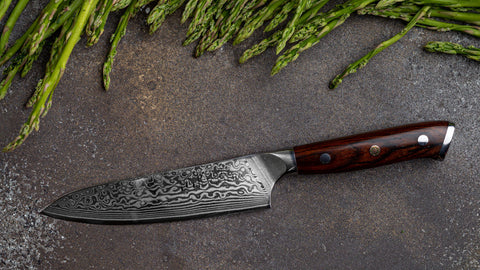The multi-duty functionality of the utility knife makes it a superstar of your kitchen knife set. As such, the utility knife should be treated with love and care to ensure that it remains effective at performing the wide range of tasks it is capable of for many years to come.
What is the utility knife commonly used for
It must first be noted that when people mention utility knives they may not be referring to the kitchen utility knife that we know and love. Many refer to a box cutter or stanley knife as a utility knife, while others refer to any knife used for manual work purposes as a utility knife too. Such knives can be used for a multitude of tasks including reshaping timber materials, unsealing cardboard boxes, cutting down cord length during home renovations, and much more.
However, the type of utility knife that this article refers to from this point forward is the handy little member of many kitchen knife sets that a lot of home cooks find themselves favoring for a vast-array of kitchen tasks.
Some of these tasks include:
- Slicing sandwiches into halves
- Peeling mandarins and other small citrus fruit
- Slicing up both thin and thick cheese products
- Cutting down popular fruits and vegetables into slices
- Trimming small cuts of meat like chicken breast
The anatomy of a utility knife
You’ll be hard pressed to find a utility knife that exceeds 7 inches in length. Normally, due to the small, precision tasks that are expected of it, the utility knife will possess a blade length between 4-6 inches. Usually, a touch larger than a paring knife, the utility knife is constructed with this length in order to cut food products that are too small for a chef’s knife but too large for a paring knife. Examples of these food items include:
- Apples
- Mid-size squash
- Potatoes
- Cucumbers
- Soft breads
- Mandarins
- Tomatoes
- Peaches
- Shallots
4 Essential Factors to ensure your utility knife is cared for
The 4 main elements that will ensure that your utility knife is able to maintain its high-level of performance relate to the following:
- Keep it Sharp
- Use a reputable cutting board
- Clean thoroughly and often
- Store properly after use
Keeping it sharp
As has been discussed before in this blog, the importance of keeping any knife sharp can not be understated. This is mainly for two reasons. A blunt blade makes life in the kitchen more difficult, but also more treacherous. The additional force required to perform a cut with a dull knife means more pressure applied, and hence a higher likelihood of the knife slipping and cutting you.
This is why it is highly recommended that any kitchen knife used on a frequent basis be sharpened with the use of a whetstone or other knife sharpening object.
Use a reputable cutting board
There is no point sharpening your knife on a regular basis if you are not going to use an adequate surface on which to cut. The general rule of thumb is never to use a surface that is harder than the knife itself. This means do not cut on a marble or glass countertop, instead utilize a cutting board. Doing so, will not only provide a stable place to perform your cuts, but will also protect the knife from damage.
Clean thoroughly and often
Sounds easy I know, but cleaning a knife is often where people do not use enough diligence and considerable damage to the knife and blade can occur. This generally happens due to the decision of the owner to place the knife in the dishwasher instead of performing a manual hand-wash.
When placing a knife in the dishwasher you are asking for trouble. This is due to the large amount of movement that the knife is subjected to - it is not uncommon for the blade to knock against other implements or the rack which can lead to damage to the blade and handle. The heat of the wash can also damage the grip.
The solution is simple. Always perform a hand-wash. Soap and lukewarm water is all that is required and a thorough dry after you have completed the wash.
Store properly
It would be a shame to go through the effort of keeping your utility knife sharp, properly cleaned and dried, only to overlook the importance of knife storage. Placing an unprotected knife blade in a kitchen drawer is simply asking for trouble. Especially, in a shared kitchen residence where it is not uncommon for people to use reckless abandon when diving into the kitchen drawers.
Consider a knife, especially one of high quality such as a Damascus steel utility knife, as an investment. Therefore placing it on a knife block or magnetic knife stand is the best possible way to ensure it is safe.